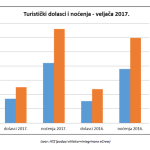There’s no doubt that Croatia is truly a stunning country with a lot to boast about. From being extremely rich in natural resources to outstanding beauty, there’s something for everyone in this very conveniently positioned little nation of a mere four million inhabitants.
Pristine beaches and the sparkling Adriatic sea, the glitz and the glamour of the Dalmatian coast, Istria’s rolling wine country, the funky Croatian capital of Zagreb, the rugged beauty of Gorski Kotar and Lika, to the golden fields of Slavonia and Baranja… the list goes on and on. The Croatian Tourist Board didn’t do badly in picking the now classic ”Croatia full of life” slogan to market the country to the rest of the world, but is it really true?
Those of us living and working here know very well that Croatia being full of life certainly isn’t true in the economic sense, unless it is providing Croatian lives to the labour markets of other countries as some sort of export product, that is. Tourists, however, get to enjoy the freedom of ”surface level Croatia”, it looks a bit like a runway model before she takes her makeup off. The sea, the sunshine, the picturesque scenery and the friendly locals who you’d never know are likely working under less than acceptable conditions paint a beautiful image of Croatia for those merely here to enjoy it. Apparently.
As Glas Istre writes on the 6th of June, 2019, stinking drains and sewers, poor and very limited public transport, overcrowded cities, national parks and beaches, and a total and utter lack of parking places are just some of the far more negative aspects of Croatia that foreign tourists claim to experience when visiting the country. Although it is indeed seen as strikingly beautiful, Croatia, as foreign guests consider it, has enormous problems in managing its destinations, according to a report from Novac.hr.
The perception and brand of Croatia itself is defined by its incredible nature and natural beauty, those are things we can’t influence (thankfully, as if we could we’d likely mess them up).
Owing to Croatia’s lucky geographical position, as many as 55.6 percent of Croatia-related announcements on social networks or any other websites and platforms mention Croatia’s abundance of sunshine, the sea, the beaches and the national parks, which are things that, rather ironically, tourists see as the only good things about the country. Nature, as Siniša Topalović, a partner in the consulting company Horwath HTL states, isn’t a term used by the Croatian Tourist Board to brand Croatia.
Croatia Full of Life is not remotely what tourists actually perceive because no events are mentioned anywhere by the aforementioned tourist board. Croatia, at least in the eyes of our visitors, is not full of life, according to Topalović. In fact, only the Croatian capital of Zagreb succeeded in living up to the ”full of life” slogan. Along with the city’s Upper Town (Gornji grad), where tourists are typically delighted with various events and festivals which are now well recognised, both during winter and summer, and tourists visiting the Croatian capital are fascinated by the city’s numerous quirky cafés and the cultural phenomenon of coffee drinking throughout the day.
On the other hand, gastronomy, which Croatia is indeed often praised for, is recognised as one of Croatia’s ”stand out” features, either. When tourists write and talk about their visit to Croatia, less than ten percent of them mention the country’s food and drink, and when they pay attention to our gastronomy, they do so in a typically very generic manner, mentioning only the basics, whereas when discussing other countries and their gastronomic offers, much more detail tends to be revealed.
However, that is actually in line with what the Croatian Tourist Board does present on their social networks. Of the total of 1,100 published pieces of content on Instagram between July and October last year, only 40 of the posts are about the country’s rich gastronomy, while out of 400 such posts on Facebook, only about 15 of them talk about food and drink. Most of the content, as expected, refers to Croatia’s natural architecture.
The results of what tourists really think of Croatia were part of pilot studies conducted jointly by the startup thinktourism and the consulting company Horwath HTL through the new eDEST platform, which should serve as a support in managing tourist destinations.
It is, as Topalović explained, an innovative tourism product that provides an insight into tourists’ perceptions about a specific country, region, destination or particular tourist attraction. EDEST gathers together all comments, posts and reviews made by tourists from all forums, social networks, blogs and other websites and analyses and compares the perception of tourists about a particular destination with what the destination is actually trying to brand.
”People write all sorts on the Internet, and more than sixty percent of tourists are just browsing when choosing a location to spend their holiday in. With younger generations, this is the case in over ninety percent of cases. Therefore, we collect what they write and publish, and we offer an insight into what tourists are saying about this location, that is, eDEST is able to see the destination through the eyes of the visitor,” explained James Chappell from Horwath HTL.
The idea for this platform came from the start-up thinktourism, whose employees noted that there was a strong discrepancy between what a particular destination would want and what it actually was portraying in the eyes of visitors.
Make sure to follow our dedicated travel page for more information on tourism in Croatia and much, much more.








